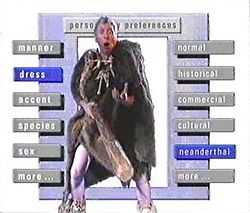Hyperland
| Hyperland | |
|---|---|
| Genre | Technology |
| Written by | Douglas Adams |
| Presented by |
Douglas Adams Tom Baker |
| Country of origin | United Kingdom |
| Original language(s) | English |
| No. of series | 1 |
| No. of episodes | 1 |
| Production | |
| Producer(s) | Max Whitby |
| Running time | 50 minutes |
| Production company(s) | BBC |
| Broadcast | |
| Original channel | BBC Two |
| Original airing | Sep. 21, 1990 [1] |
Hyperland is a 50-minute long documentary film about hypertext and surrounding technologies. It was written by Douglas Adams and produced and directed by Max Whitby[2] for BBC Two in 1990. It stars Douglas Adams as a computer user and Tom Baker, with whom Adams had already worked on Doctor Who, as a personification of a software agent.
In hindsight, what Hyperland describes and predicts is an approximation of today's World Wide Web.[3]
Content
The self-proclaimed "fantasy documentary" begins with Adams asleep by the fireside with his television still on. In a dream that follows, Adams, fed up by game shows and generally passive, non-interactive linear content, takes his TV to a rubbish dump, where he meets Tom, played by Tom Baker. Tom is a software agent, who shows him the future of TV: interactive multimedia.[4]

Much like Apple Inc's Knowledge Navigator concept, Tom acts as a butler within a virtual space populated with hypermedia: linked text, sound, pictures and movies represented by animated icons. The documentary is centred on Adams browsing these media and discovering their interconnectedness.
This process leads him, for example, from the topic Atlantic Ocean to literature about the sea to The Rime of the Ancient Mariner by Samuel Taylor Coleridge to the poem Kubla Khan by the same author to Xanadu and back to the topic of hypertext via Ted Nelson's Project Xanadu. The references to Coleridge and to Kubla Khan are rather knowing nods to Adams' own book Dirk Gently's Holistic Detective Agency, where they play significant roles in the plot. Dirk Gently was published in 1987 and also touches on the themes of interconnectedness, suggesting that this was a subject Adams had thought about at some length and some time.
Many aspects of the documentary demonstrate Adams' noted enthusiasm for technology, and for Apple computers in particular. At the beginning of the documentary a Macintosh Portable can be seen, and most of the projects presented run on Apple hardware. Even the general design of the animated icons and environments featured in his dream are inspired by pre-OS X era Mac OS icons and design cues.
Multimedia
While Adams is browsing, many people and projects related to the general theme of hypertext and multimedia are presented:
- Vannevar Bush and his Memex[5] concept of a theoretical proto-hypertext information system are shown.
- Ted Nelson explains hypertext and Project Xanadu.
- Hans Peter Brøndmo talks about the concept of animated icons.
- Robert Winter talks about an interactive version of Beethoven's 9th Symphony.
- An idea from Kurt Vonnegut's book Palm Sunday is presented: stories and narrative structures have shapes that can be represented mathematically as graphs.
- Robert Abel shows his multimedia version of Picasso's Guernica.[6]
- Apple Multimedia Lab employees Steve Gano, Kristee Kreitman, Kristina Hooper, Michael Naimark and Fabrice Florin talk about a multimedia version of Life Story, a BBC TV film dramatisation of the 1953 discovery of the structure of DNA.
- Amanda Goodenough presents Inigo Gets Out, an interactive story for children implemented with Hypercard.
- Brad deGraf and Michael Wahrman talk about their digital puppet Mike Normal.
- A NASA Ames Research Center scientist presents a prototype Virtual Reality helmet called Cyberiad.
- Marc Canter makes a cameo (non-)appearance as an animated icon that isn't "clicked" by Adams; the audience never gets to see his interview.
The dream (and the documentary) ends with a vision of how information might be accessed in 2005. In hindsight, Hyperland does describe a number of features of the modern web and, apart from some underestimates of graphics and processing power available, the documentary paints a not inaccurate picture of hypermedia and hypertext and how they are used today. This is especially noteworthy considering that it predates the public release of the first Web browser by about a year.
References
- ↑ TheTVDB.com
- ↑ Ted Nelson: Possiplex. 2010, page 272f.
- ↑ "The Internet – the last battleground of the 20th century". The BBC. Retrieved 16 December 2014.
- ↑ "Hyperland". douglasadams.com. Retrieved 1 May 2012.
- ↑ Vannevar Bush (July 1945). "As We May Think". The Atlantic. Retrieved 1 May 2012.
- ↑ Robert Epstein (29 January 1991). "'Future Tense': The New Link Between Arts and Technology". Los Angeles Times. Retrieved 1 May 2012.
External links
- Douglas Adams Homepage about Hyperland
- An excerpt from the documentary featuring Ted Nelson
- Hyperland at the Internet Movie Database
| ||||||||||||||||||||||||||